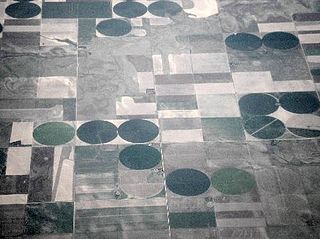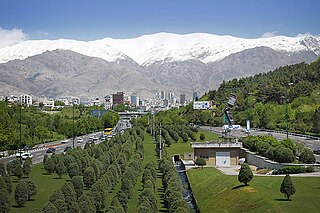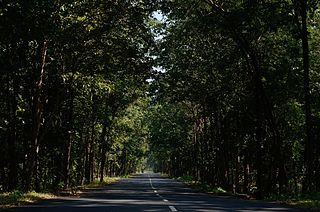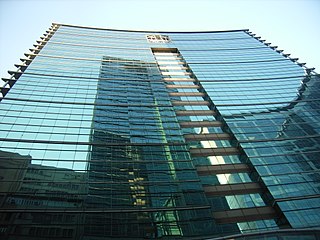Related Research Articles
An urban growth boundary, or UGB, is a regional boundary, set in an attempt to control urban sprawl by, in its simplest form, mandating that the area inside the boundary be used for urban development and the area outside be preserved in its natural state or used for agriculture. Legislating for an "urban growth boundary" is one way, among many others, of managing the major challenges posed by unplanned urban growth and the encroachment of cities upon agricultural and rural land.

In urban planning, zoning is a method in which a municipality or other tier of government divides land into "zones", each of which has a set of regulations for new development that differs from other zones. Zones may be defined for a single use, they may combine several compatible activities by use, or in the case of form-based zoning, the differing regulations may govern the density, size and shape of allowed buildings whatever their use. The planning rules for each zone determine whether planning permission for a given development may be granted. Zoning may specify a variety of outright and conditional uses of land. It may indicate the size and dimensions of lots that land may be subdivided into, or the form and scale of buildings. These guidelines are set in order to guide urban growth and development.

A farm is an area of land that is devoted primarily to agricultural processes with the primary objective of producing food and other crops; it is the basic facility in food production. The name is used for specialized units such as arable farms, vegetable farms, fruit farms, dairy, pig and poultry farms, and land used for the production of natural fiber, biofuel, and other commodities. It includes ranches, feedlots, orchards, plantations and estates, smallholdings, and hobby farms, and includes the farmhouse and agricultural buildings as well as the land. In modern times, the term has been extended so as to include such industrial operations as wind farms and fish farms, both of which can operate on land or at sea.

A green belt is a policy, and land-use zone designation used in land-use planning to retain areas of largely undeveloped, wild, or agricultural land surrounding or neighboring urban areas. Similar concepts are greenways or green wedges, which have a linear character and may run through an urban area instead of around it. In essence, a green belt is an invisible line designating a border around a certain area, preventing development of the area and allowing wildlife to return and be established.

Urban agriculture refers to various practices of cultivating, processing, and distributing food in urban areas. The term also applies to the area activities of animal husbandry, aquaculture, beekeeping, and horticulture in an urban context. Urban agriculture is distinguished from peri-urban agriculture, which takes place in rural areas at the edge of suburbs.
The Agricultural Land Reserve (ALR) is a collection of agricultural land in British Columbia in which agriculture is recognized as the priority. In total, the ALR covers approximately 47,000 square kilometres (18,000 sq mi) and includes private and public lands that may be farmed, forested or are vacant. Some ALR blocks cover thousands of hectares while others are small pockets of only a few hectares. The reserve is administered by the Agricultural Land Commission (ALC), consisting of a chair and six vice-chairs appointed by the Lieutenant Governor-in-Council of British Columbia (cabinet) and twelve regular commissioners appointed by the provincial Minister of Agriculture.

Agriculture, forestry, and fishing form the primary sector of industry of the Japanese economy together with the Japanese mining industry, but together they account for only 1.3% of gross national product. Only 20% of Japan's land is suitable for cultivation, and the agricultural economy is highly subsidized.

Social forestry is the management and protection of forests and afforestation of barren and deforested lands with the purpose of helping environmental, social and rural development. The term social forestry was first used in 1976 by The National Commission on Agriculture, when the government of India aimed to reduce pressure on forests by planting trees on all unused and fallow lands. It was intended as a democratic approach to forest conservation and usage, maximizing land utilization for multiple purposes.
Farmland preservation is a joint effort by non-governmental organizations and local governments to set aside and protect examples of a region's farmland for the use, education, and enjoyment of future generations. They are operated mostly at state and local levels by government agencies or private entities such as land trusts and are designed to limit conversion of agricultural land to other uses that otherwise might have been more financially attractive to the land owner. Every state provides tax relief through differential (preferential) assessment. Less common approaches include establishing agricultural districts, using zoning to protect agricultural land, purchasing development rights, and transferable development rights. It is often a part of regional planning and national historic preservation.

Zoning is a law that divides a jurisdiction's land into districts, or zones, and limits how land in each district can be used. In the United States, zoning includes various land use laws enforced through the police power rights of state governments and local governments to exercise authority over privately owned real property.
Development-supported agriculture is a nascent movement in real estate development that preserves and invests in agricultural land use. As farmland is lost due to the challenging economics of farming and the pressures of the real estate industry, DSA attempts to reconcile the need for development with the need to preserve agricultural land. The overall goal of DSA is to incubate small-scale organic farms that co-exist with residential land development, providing benefits to farmers, residents, the local community, and the environment.
Transferable development rights (TDR) is a method by which developers can purchase the development rights of certain parcels within a designated "sending district" and transfer the rights to another "receiving district" to increase the density of their new development. The underlying legal concept of a transfer of development rights programme is the notion that all land has a bundle of property rights. It is used for controlling land use to complement land-use planning and zoning for more effective urban growth management and land conservation.

Right to farm laws in the United States deny nuisance lawsuits against farmers who use accepted and standard farming practices and have been in prior operation even if these practices harm or bother adjacent property owners or the general public. Agricultural nuisances may include noise, odors, visual clutter and dangerous structures. All 50 states have some form of Right to Farm law.

The Agricultural Reserve is a designated land use zone in Montgomery County, Maryland. The 93,000 acres (380 km2) zone was created in 1980 by the Montgomery County Council to preserve farm land and rural space in the northwestern part of the county. The farmland protection program has been characterized as "the most famous, most studied and most emulated" program of its kind in the United States.
Preservation development is a model of real-estate development that addresses farmland preservation. It shares many attributes with conservation development, with the addition of strategies for maintaining and operating productive agriculture and silviculture, often in perpetuity. A preservation development is a planned community that allows limited, carefully designed development on a working farm, while placing the majority of productive land under a system of easements and community governance to ensure a continuity of farming and environmental stewardship.
The term Jim Crow economy applies to a specific set of economic conditions in the United States during the period when the Jim Crow laws were in effect to force racial segregation; however, it should also be taken as an attempt to disentangle the economic ramifications from the politico-legal ramifications of "separate but equal" de jure segregation, to consider how the economic impacts might have persisted beyond the politico-legal ramifications.

Collective farming and communal farming are various types of "agricultural production in which multiple farmers run their holdings as a joint enterprise". There are two broad types of communal farms: agricultural cooperatives, in which member-owners jointly engage in farming activities as a collective; and state farms, which are owned and directly run by a centralized government. The process by which farmland is aggregated is called collectivization. In some countries, there have been both state-run and cooperative-run variants. For example, the Soviet Union had both kolkhozy and sovkhozy.

Urban agriculture in West Oakland involves the implementation of Urban agriculture in West Oakland, California.
Land reform in South Africa is the promise of "land restitution" to empower farm workers and reduce inequality. This also refers to aspects such as, property, possibly white-owned businesses. Proponents argue it will allow previously unemployed people to participate in the economy and better the country's economic growth. It also relates to restitution in the form of settling Land Claims of people who were forcefully removed from their homes in urban areas that were declared white, by the apartheid government's segregationist Group Areas Act: such areas include Sophiatown, Fietas, Cato Manor, District Six and Greyville; as well as restitution for people forcibly evicted from rural land because of apartheid policies.

The Town Planning Board is a statutory body of the Hong Kong Government tasked with developing urban plans with an aim to ensuring the "health, safety, convenience and general welfare of the community through the process of guiding and controlling the development and use of land, and to bring about a better organised, efficient and desirable place to live and work." It is founded upon section 2 of the Town Planning Ordinance.
References
- ↑ L, Millman (2021-01-25). "What Type of Structures Can You Build on Agricultural Land?". Millman Land. Retrieved 2021-04-06.
- ↑ Linkous, Evangeline R. (2019). "Rural Zoning: Land Use Policy in a Contested and Neglected Landscape". In Sclar, Elliott; et al. (eds.). Zoning: A Guide for 21st-Century Planning. Abingdon-on-Thames, UK: Routledge. p. 93. ISBN 9780429951251.
- ↑ Nelson, Kevin (February 2012). "Essential Smart Growth Fixes for Rural Planning, Zoning, and Development Codes" (PDF).
- ↑ Nelson, Arthur C.; Pruetz, Rick; Woodruff, Doug (2011). The TDR Handbook: Designing and Implementing Transfer of Development Rights Programs. Washington: Island Press. p. 141. ISBN 9781610911597.
- ↑ "Ag Reserve,Office of Agricultural Services, Montgomery County, MD". www.montgomerycountymd.gov. Retrieved 2024-01-31.
- ↑ Henneberry, David M.; Barrows, Richard L. (1990). "Capitalization of Exclusive Agricultural Zoning into Farmland Prices". Land Economics. 66 (3): 249–258. doi:10.2307/3146727. ISSN 0023-7639. JSTOR 3146727.
- ↑ Kruft, David (August 2001). "Agricultural Zoning" (PDF). Penn State Law.
- 1 2 Popp, Teri E. (1989). "A Survey of Agricultural Zoning: State Responses to the Farmland Crisis". Real Property, Probate and Trust Journal. 24 (3): 371–402. ISSN 0034-0855. JSTOR 20781905.
- 1 2 3 4 5 6 7 Nelson, Robert H. (1984), Baden, John (ed.), "Agricultural Zoning: A Private Alternative", The Vanishing Farmland Crisis, Critical Views of the Movement to Preserve Agricultural Land, University Press of Kansas, pp. 113–144, doi:10.2307/j.ctv1p2gk52.11, ISBN 978-0-7006-0253-7, JSTOR j.ctv1p2gk52.11 , retrieved 2024-03-03
- ↑ Deaton, B. James; Hoehn, John P.; Norris, Patricia E. (2007-05-01). "Net Buyers, Net Sellers, and Agricultural Landowner Support for Agricultural Zoning". Land Economics. 83 (2): 153–165. doi:10.3368/le.83.2.153. ISSN 0023-7639.
- ↑ Becker, John C. (2002). "Promoting Agricultural Development Through Land Use Planning Limits". Real Property, Probate and Trust Journal. 36 (4): 619–671. ISSN 0034-0855. JSTOR 20782253.